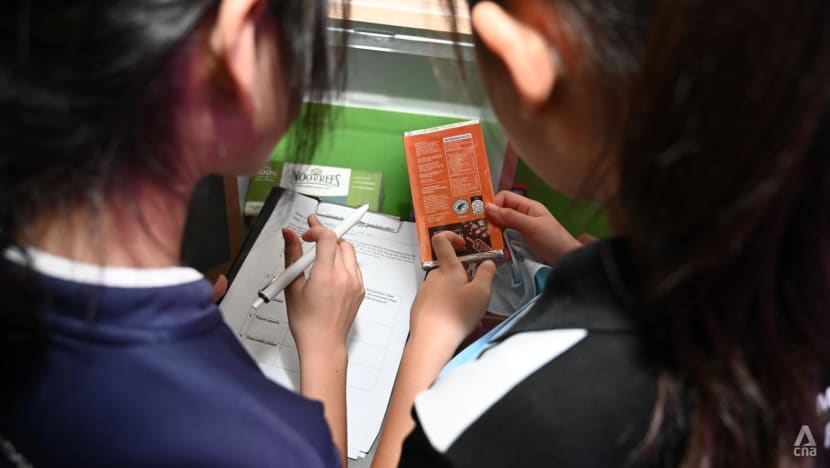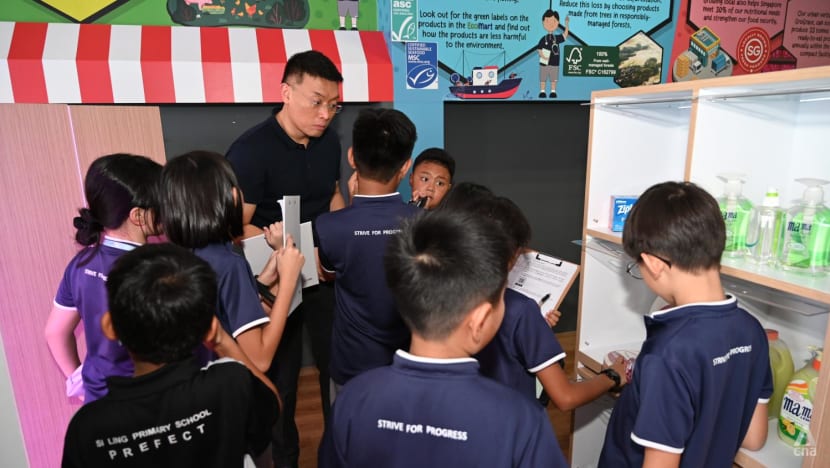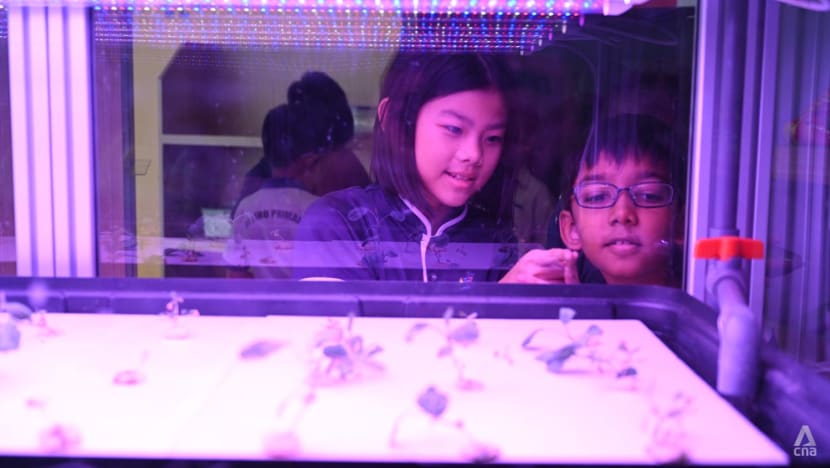Unpacking food sustainability: One school puts responsible grocery shopping in its curriculum
Students at Si Ling Primary learn the ABCs of responsible shopping - avoid impulse buying, buy less, choose well - at the school's sustainability concept store.

Si Ling Primary School students looking for eco-friendly labels on food items at the school's EcoMart. (Photo: CNA/Raydza Rahman)
SINGAPORE: "Is there a dolphin-safe label or a Certified Sustainable Seafood label on the can of tuna?" The buzzing excitement was palpable as students of 4 Solidarity scrutinised the products displayed at the school's EcoMart during their science lesson.
With its walls filled with information about buying local produce, overfishing and sustainable materials, this "supermarket" is a sustainability concept store in Si Ling Primary School.
It is part of the school's applied learning programme initiative to empower students to drive environmental efforts not only within the school, but also at home and within the community.
Food sustainability will be the focus in schools in 2023, Minister of State for Education Gan Siow Huang had said in her speech at the Committee of Supply debates in March.
The Education Ministry will support schools in emphasising sustainable food production in the curriculum, and setting up facilities for students to apply what they learn about food production and food waste management, she said.

LEARNING ABOUT FOOD SUSTAINABILITY
On a visit to Si Ling Primary in February, CNA watched as their science teacher Mr Ashri Shukri started the lesson by asking the students if they often shop for groceries with their parents. Most of them indicated that they did.
"Can the choice you make at the supermarket impact the environment?" he asked them. The students responded with a loud, resounding yes.
The class was then tasked with organising a hypothetical picnic. The students were to find and "purchase" tuna, chocolates, tissue paper and disposable plates for the event. But there was a catch - they had to choose the most environmentally friendly option for each item.
Split up into groups of three or four, the students were handed tablets to watch videos about topics such as plastic pollution, and read up on the different well-recognised labels that indicate environmental sustainability.
For example, a dolphin-safe label indicates that the company catches its tuna using methods that do not harm dolphins and protect the marine ecosystem. A Forest Stewardship Council (FSC) certification ensures that wood products like paper towels come from responsibly managed forests.
A Certified Sustainable Seafood label from the Marine Stewardship Council means that the seafood has been caught in a way that ensures sustainable fish supply in waters now and in the future.
The students were left to their own devices as they made their way around the EcoMart, stopping to read the instructions on the walls and fill up their worksheets while having hearty discussions with their teammates.
This approach encourages students to conduct research and find the information themselves, Mr Ashri told CNA in an interview after the lesson concluded.
"At the end of the day, we want to make learning about sustainability come to life for students, because if we provide opportunities for students to practise responsible decision-making and informed decision-making, it makes it more interesting," he added.
Different levels also learn about different aspects of food sustainability. For example, the primary 6 students learn about how the distance travelled by food products contributes to climate change, said Mr Ashri, adding that their task includes comparing the country of origin of the products and calculating the distances they had travelled before deciding which ones to buy.
Giving students a chance to apply their knowledge or use the information in a new situation allows for deeper learning and they can make meaningful connections, he said.

After answering some questions about the different labels and ways to reduce their meat consumption and food packaging waste, the primary 4 students went around the EcoMart looking for the ingredients they needed for the picnic.
Each shelf at the sustainability concept store holds the same product from different brands and students huddled in front of each of them, deciding on the most environmentally friendly options.
Most of them were quick to point out that one of the paper towel options had an FSC label while the other two did not.
Other conscientious students pored over the cans of tuna looking for the correct labels while trying to get their team members to look for the other ingredients.
In learning about how to look for environmentally friendly options at the supermarket, the hope is that students bring this knowledge home and share it with their parents.
The EcoMart can teach students that the simple act of buying more sustainable goods can help to minimise carbon emissions, conserve natural resources and reduce waste, said Mr Ashri.
“It takes a kampung to raise a sustainable nation, so it should not be within our school, but also with families and the community,” he continued.
He added that to "kickstart the ripple effect", the school taps into a small aspect of daily life that both parents and students can do - which is shopping.

“We learnt how to shop sustainably and we have this new catchphrase ABC - A for avoid impulse buying, B for buy less and C for choose well,” said Chai Xin Lyn, a primary 5 environment ambassador who went through the lesson last year.
“We’ll explain to our parents, then we’ll go shopping, we’ll just follow them and show them the different labels,” she added.
The other environment ambassadors chimed in with stories of how they explained the meaning of the different labels to their parents. They said that their parents did listen to their instructions while shopping, adding that their parents were happy and proud that they learnt about these things in school.
“Sometimes my mother when she goes shopping, when she sees something on sale she says it’s better to buy it because it’s cheaper,” said Akif Muhammad Adam.
“I told my mum that it’s better not to buy things that are on sale … Sometimes we have a shopping list, so just follow the shopping list and buy less,” he added.
Xin Lyn continued: “Basically, we avoid impulse buying, but to avoid that, we need a list so that we can just stick to that, and try to avoid the other products with a beautiful container.”
Another environment ambassador Kumaresan Sowmitha added: “It’s like when you see chocolate milk, strawberry milk, usually you’re like ‘I want this, I want that,” but no. You just have to stick to the list your mother gave you.”
“My father doesn’t write it in a note - my mother messages what to buy and then he will just look at the message and buy it. If my father wants something else from the shop, he’ll ask permission from my mother,” she added with a cheeky laugh.
“They won’t think like, this is a small kid, why should we listen? They are more like, it’s our child, so they put effort into listening to us.”

The EcoMart also houses a small vertical hydroponic farm, which is used in other lessons where students learn about growing vegetables locally, Mr Ashri explained.
In another applied learning programme session, the primary 5 environment ambassadors had the opportunity to grow their own hydroponics vegetables.
They grew some chye sim and xiao bai cai, and brought their harvests home. “The amount was actually quite surprising,” said another student Teo Jing You, adding that there was less than she expected after such hard work.
“In the December holidays, we went to the residents' committee and we introduced to everybody there about the hydroponics farm,” she added.
While significant measures like using solar panels can help to conserve or sustain the environment, small things like consumer habits can also go a long way, said Mr Ashri.
Read this story in Bahasa Indonesia here.
Read this story in Bahasa Melayu here.














